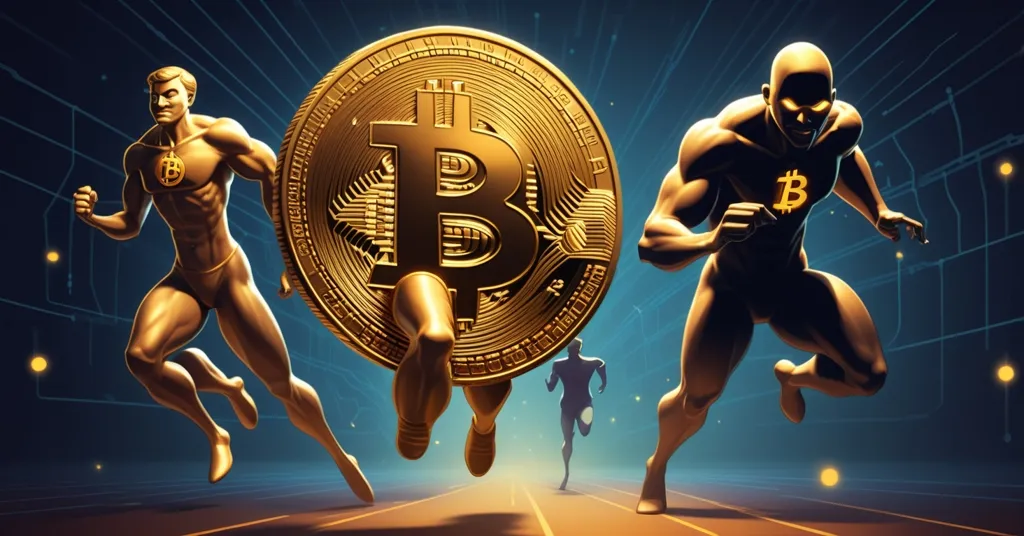Altcoin Summer 2025: Can Solana and Mutuum Finance Rival Bitcoin’s Dominance?

Altcoin Summer 2025: Can Solana and Mutuum Finance Challenge Bitcoin’s Reign?
Summer in the crypto world often ignites a speculative spark, with traders hunting for the next big thing while Bitcoin takes a breather. This year, the buzz is around altcoins like Solana (SOL) and Mutuum Finance (MUTM), which are turning heads with promises of outsized returns and cutting-edge tech. But can they truly outshine Bitcoin (BTC), the unshakeable titan of digital value?
- Mutuum Finance (MUTM): A DeFi presale project at $0.03, claiming $11.4 million raised and a 100% ROI upon listing.
- Solana (SOL): Trading near $150, hyped for scalability and growing institutional ties.
- Bitcoin (BTC): Hovering around $107,385, stuck in a consolidation rut despite ETF tailwinds.
Mutuum Finance: Presale Hype or Risky Gamble?
Mutuum Finance has stormed onto the scene with a presale that’s reportedly pulled in $11.4 million from over 12,600 early investors, pricing its token at a dirt-cheap $0.03. The pitch is seductive: a 16.67% return by Phase 6 when the price hits $0.035, and a jaw-dropping 100% ROI once it lists on exchanges. To top it off, they’re dangling a $100,000 giveaway, with 10 lucky winners grabbing $10,000 in tokens each and a leaderboard rewarding the top 50 holders. For thrill-seekers, it’s like spotting a lottery ticket on the sidewalk. But let’s not get blinded by the shine—there’s plenty of shadow here.
What makes Mutuum stand out in the overcrowded DeFi arena is its dual lending model. For the uninitiated, DeFi—or Decentralized Finance—builds financial tools on blockchain tech, cutting out middlemen like banks for lending, borrowing, or trading. Mutuum offers Peer-to-Peer (P2P) lending, where you directly negotiate terms with another user, like lending cash to a buddy with a handshake deal. Then there’s Peer-to-Contract (P2C), an automated setup using blockchain code to pool funds and maximize profits, akin to a vending machine spitting out the best deal for your money. This flexibility is pitched as a way to thrive in volatile markets, especially with speculative assets like meme coins. They’ve also got a CertiK audit under their belt—a stamp of approval from a top blockchain security firm that stress-tested their code for vulnerabilities—plus a $50,000 bug bounty program inviting ethical hackers to find flaws. On the horizon, a USD-pegged stablecoin built on Ethereum aims to bring some calm to crypto’s stormy seas. For more on their presale claims and credibility, check out this detailed report on Mutuum Finance’s $11.4 million raise.
Yet, here’s where the red flags start waving. Community chatter on platforms like Reddit points to murky details: some claim only $500,000 was raised in Phase 1, casting doubt on the $11.4 million figure. There’s also zero transparency around the team—no names, no faces—and no public contract addresses to verify. If this sounds like a rerun, it is. The 2021 DeFi boom was littered with presale projects promising the moon, only to rug-pull investors or fizzle out with unsustainable models. Mutuum might be different, but history screams for caution. That 100% ROI? Let’s cut the crap—nobody can predict that in crypto’s Wild West, and peddling such guarantees smells borderline fraudulent. For deeper insights into community concerns, here’s a Reddit thread on Mutuum Finance presale risks.
Solana: Speed Demon with Hidden Bumps
Shifting gears, Solana emerges as a heavyweight contender, trading around $150 with a reputation for lightning-fast transactions and dirt-cheap fees. Unlike Bitcoin’s sluggish 7 transactions per second (TPS) or Ethereum’s 15-30 TPS pre-upgrades, Solana clocks over 50,000 TPS, making it a playground for DeFi developers and NFT creators needing speed. Its ecosystem boasts a Total Value Locked (TVL) of $8.56 billion—basically, the amount of money staked or invested in its financial apps, signaling serious trust and capital. If you’re new to this tech, here’s a comprehensive overview of Solana’s blockchain technology to get you up to speed. Institutional interest is heating up too, with U.S. banks dipping toes into Solana-based projects and a buzz around ETFs like the upcoming REX Shares and Osprey Funds Solana ETF (SSK), set for July 2025 with staking rewards. Analysts call this a regulatory nod for altcoin ETFs, even projecting a $200 price target for SOL by year-end if the “Solana Summer” narrative sticks. Real-world bridges, like tokenized stocks (think Apple or Tesla shares via xStocks on Raydium), further cement its role as a link between old finance and new.
But don’t slap on the rose-colored glasses just yet. Solana’s got issues lurking under the hood. Technical signals, like a dipping Relative Strength Index (RSI) near 40, hint at near-term volatility, with potential drops below $143. Revenue has tanked 90% since early 2025, per some market watchers, and regulatory storm clouds loom large. The SEC has previously labeled SOL a security, which could choke ETF approvals or broader adoption. Then there’s validator centralization—around 19 validators control over 50% of the network’s stake, a far cry from Bitcoin’s sprawling mining decentralization. If these key players collude or go offline, the network’s security could crumble. Past outages in 2021-2022 don’t help its reliability rap either. For more on this, here’s an update on Solana’s network centralization challenges. Solana’s a speedster, no doubt, but it’s racing on a track with plenty of potholes.
Bitcoin: The Sleeping Giant Still Holds Court
While altcoins steal the spotlight, Bitcoin sits at $107,385, seemingly dozing through the summer heat. Despite the hype of spot ETF approvals fueling mainstream adoption—with heavyweights like BlackRock’s IBIT seeing massive inflows—BTC’s price action remains a yawn-inducing sideways shuffle. This isn’t unusual; Bitcoin often consolidates after big catalysts, opening windows for “altcoin season” where speculative cash chases riskier bets. But let’s not underestimate the king. Bitcoin’s hash rate—the computing power securing its network—is at all-time highs, making it the most unassailable blockchain out there. It’s not built for DeFi or flashy apps; it’s digital gold, a fortress of value no altcoin can fully dethrone yet. Slower speeds (7 TPS) and higher fees keep it out of the app-building race, but for institutional portfolios or anyone dodging inflation, BTC remains the safe harbor. Curious if other cryptos could surpass it? Here’s a perspective on top cryptos that might outperform Bitcoin this summer.
Looking at past cycles, like 2019-2020, these consolidation phases often precede explosive moves. Macro factors—think interest rate shifts or the next halving cutting supply—could jolt Bitcoin awake sooner than expected. While Solana’s speed and Mutuum’s promises dazzle, Bitcoin’s staying power reminds us that slow and steady often outlasts the flavor of the month.
The Bigger Picture: Hype vs. Hard Lessons
So why the fever around Mutuum Finance and Solana over Bitcoin? Mutuum taps into the get-rich-quick allure of presales, dangling high-stakes gambles with fresh DeFi lending ideas—if you ignore the neon warning signs. For a broader discussion on their approach, check out these community reviews of Mutuum Finance’s DeFi lending models. Solana’s got a proven edge with scalability and real ties to traditional finance, positioning it as a sidekick with serious potential. To understand if it could rival Bitcoin, here’s a comparison of Solana and Bitcoin as investments. But neither escapes the crypto market’s brutal reality: volatility, regulatory landmines, and the ghosts of past scams.
Mutuum’s playbook echoes the 2021 yield farming craze, where countless projects hyped triple-digit returns only to implode, leaving early investors holding the bag. If you’re wary of such pitfalls, this guide on identifying DeFi presale scams is a must-read. Solana, for all its tech cred, isn’t immune to a regulatory smackdown or network hiccups that could cool its hot streak. For the latest on its institutional adoption and ETF rumors, here’s a report on Solana’s growing ties with U.S. banks. Bitcoin, meanwhile, shrugs off the drama—its biggest risk is boredom, and even that’s temporary. Summer sizzle in crypto often comes with burns, especially when macro headwinds or liquidity crunches hit. Balancing the thrill of innovation with hard-learned skepticism is the only way to navigate this jungle.
Key Takeaways and Questions for Crypto Enthusiasts
- What’s driving the hype around Mutuum Finance this summer?
Its presale has reportedly raised $11.4 million, backed by innovative P2P and P2C lending models and a CertiK audit for credibility, though unverified funding claims and team anonymity raise serious doubts. - Why is Solana seen as a Bitcoin rival right now?
Solana’s blistering speed (50,000+ TPS), low fees, $8.56 billion DeFi TVL, and institutional moves like potential ETFs outpace Bitcoin’s current sideways grind and sluggish network. - Does Bitcoin still have an edge over these altcoins?
Absolutely—Bitcoin’s unmatched security, market dominance, and role as digital gold make it the lowest-risk play, even if it lacks the DeFi or app appeal of Solana or Mutuum. - What risks should investors watch with presale projects like Mutuum Finance?
Beware of anonymous teams, inflated funding numbers, and wild ROI promises; history shows DeFi presales often end in rug pulls or losses for early backers who skip due diligence. - How might regulatory or technical issues derail Solana’s momentum?
SEC disputes over SOL’s status as a security, validator centralization (19 control over 50% of stake), and past network outages could stall ETF approvals or trust in the blockchain.
Summer 2025 is shaping up to be a battleground for crypto’s old guard and new challengers. Mutuum Finance could be a DeFi dark horse or another cautionary tale waiting to unfold. Solana’s growth is backed by real tech and traction, but it’s not bulletproof against market or legal turbulence. Bitcoin, for all its current slumber, remains the bedrock of this space—a reminder that sometimes the tortoise outlasts the hares. Keep your skepticism sharp, your research thorough, and your bets measured. The crypto race is on, but picking winners in this heat takes more than blind faith.



